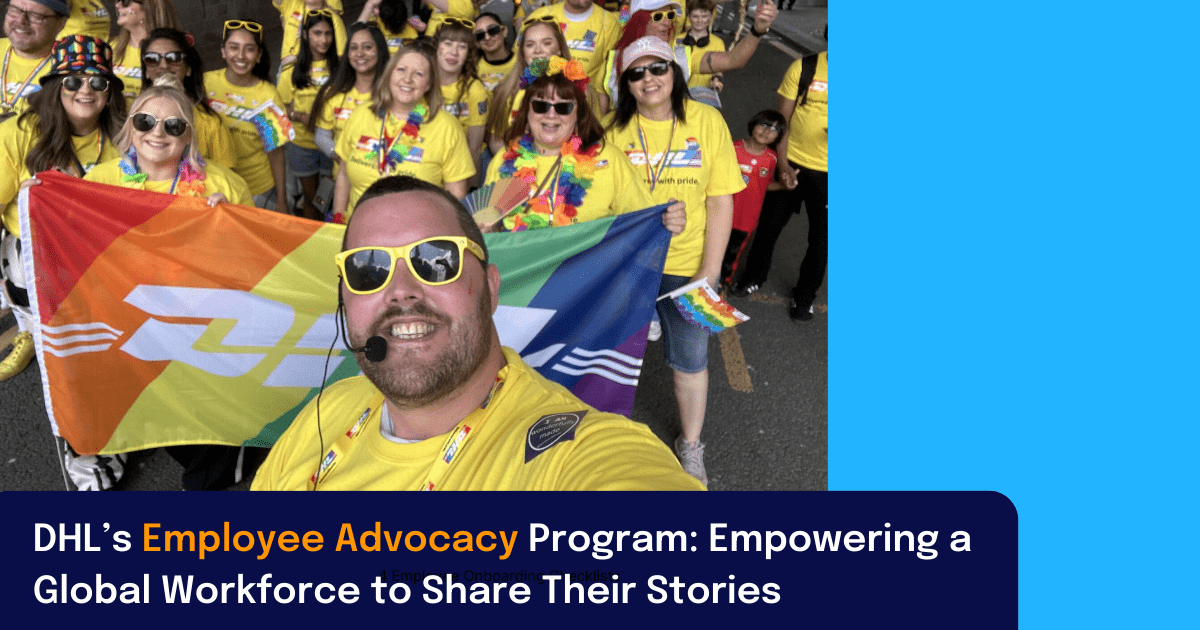The way we work has changed, and so has the way we welcome new employees. Unlike traditional onboarding, which relies on face-to-face interactions, remote onboarding depends on digital tools to help new hires feel like part of the team from day one. And it’s no longer just a temporary solution—remote onboarding is an essential part of building a strong, connected modern workforce.
But without the right strategy, onboarding remote employees can feel disconnected, leading to lower performance and higher turnover. That’s where a strong onboarding plan and the right communication tools make all the difference when it comes to maximizing remote employee engagement.
What is remote employee onboarding?
Remote employee onboarding is pretty straightforward to define. However, as you’ll soon discover, careful thought makes all the difference when it comes to post-onboarding engagement.
Remote onboarding is the process of integrating new hires into a company when they work remotely. The process provides the necessary resources, tools, and connections to help them succeed apart from a physical office. Remote employee onboarding is a convenient process that allows for a seamless onboarding experience for both remote and hybrid workers.
Unlike traditional employee onboarding, which often includes in-person meetings, office tours, and desk setups, remote onboarding relies on digital solutions. Video calls, onboarding checklists, employee apps, and internal newsletters replace physical interactions to ensure a smooth transition.
Remote onboarding is becoming an increasingly popular way to welcome new employees, especially since a Survey of Business Uncertainty report found that 27% of employees currently work remotely or in hybrid mode. Not only has this number skyrocketed in the past 5 years, but it’s predicted to continue to rise in the following years as more employees embrace and expect flexible working environments.
Why remote onboarding matters
A strong remote onboarding process helps new employees quickly understand their role, build relationships, and feel engaged from day one. Companies that prioritize a structured onboarding plan see improved employee retention, higher productivity, increased engagement, and stronger team connections. Let’s look at some numbers:
- First, there’s a lot of room for improvement. Only 12% of employees strongly agreed that their organization did a great job of onboarding new employees, according to Gallup.
- This is concerning, as a different Gallup study found that engaged business units have an average of 21% increased productivity. Furthermore, it concluded that engaged employees drive higher profitability, reduce turnover, decrease absenteeism, and boost customer satisfaction.
- Overall, companies with a structured onboarding process see a 62% increase in new hire productivity and a 50% boost in retention, according to SHRM.
Without an effective onboarding program, new hires feel disconnected and disengaged—which costs companies big time. In contrast, quick and thorough onboarding processes allow employees to get started on their roles quickly as they rapidly integrate into their new working environment.
The remote onboarding process: How to onboard new employees remotely

When it comes to how to onboard remote employees, it’s always best to have a plan. A well-structured remote onboarding process ensures that new hires feel engaged, informed, and set up for success from the very start. Without a structured approach, remote employees can struggle with unclear expectations, lack of connection, and difficulty accessing key resources.
To ensure a seamless experience while reinforcing company culture and improving employee engagement, it’s necessary to have a step-by-step remote onboarding plan. This plan should cover every step of the onboarding process, such as the one outlined below.
Pre-boarding (before day 1): Laying the foundation
Before a new hire officially starts, HR teams should ensure they have everything they need to hit the ground running. A strong pre-boarding process minimizes uncertainty, builds excitement, and sets clear expectations. Pre-boarding steps include:
- IT setup: Ensure employees have login credentials for employee email, communication platforms, and essential project management tools. An onboarding checklist helps streamline this process.
- Welcome email: Send an email with a personalized message, company introduction, and next steps. Include access to the employee handbook and policies.
- Company culture introduction: Share videos, a digital welcome kit, or an internal newsletter that highlights core values and mission statements should be shared. Employees can connect with their new team and get familiar with the company through their employee app.
- Pre-start team introduction: Schedule a video call with a manager or mentor so employees feel connected before their first day.
Day 1: Setting the tone
The first day is about creating a warm, organized, and engaging introduction. New hires should feel welcomed and have a clear understanding of their role.
- Virtual meet-and-greet: Host a video call where the new hire meets their team and potentially key stakeholders.
- Essential tools overview: Walk through platforms employees will use daily, including employee apps, communication channels, and workflow systems.
- Clear role expectations: Outline job responsibilities, key tasks, and immediate goals for the first few weeks.
Week 1: Building engagement & confidence
The first week is critical in shaping the new hire’s onboarding experience. This phase should provide structured learning opportunities and encourage early engagement.
- Mentorship or buddy system: Assign a dedicated team member who can answer questions and help the new hire navigate their role.
- Training sessions: Conduct job-specific training sessions that cover company workflows, technology, and best practices.
- Team interaction opportunities: Encourage participation in group chats, virtual team coffee breaks, and collaborative projects to strengthen team bonding.
- Regular updates via internal newsletters: Keep employees informed about company-wide developments through digital communication.
First Month: Reinforcing learning & gathering feedback
By the end of the first month, employees should have a solid grasp of their responsibilities and company culture. This period should focus on deeper learning and continuous feedback.
- Regular manager check-ins: One-on-one meetings help assess progress, clarify expectations, and address concerns.
- Feedback collection: Send surveys or conduct informal discussions to understand their onboarding experience and improve the process for future hires.
- Skill development opportunities: Introduce additional training, cross-functional learning, or career coaching programs.
Ongoing support: Creating long-term success
Onboarding shouldn’t stop after the first month. Continuous learning, mentorship, and company culture reinforcement ensure long-term engagement and retention.
- Ongoing mentorship and learning opportunities: Offer leadership training, skills development, and continuous education programs.
- Foster culture remotely: Keep remote employees engaged with virtual events, recognition programs, and open communication on employee channels.
- Leverage an employee app: Provide easy access to company updates, training materials, and key resources to ensure a smooth transition beyond a new hire’s first 90 days.
Overall, by implementing a structured remote onboarding process, organizations create a stronger, more connected workforce that feels supported, engaged, and ready to contribute.
Remote onboarding best practices
Companies should focus on clear communication, mentorship, and engagement to improve remote employee onboarding. Here’s how companies can enhance their remote onboarding experience by adhering to remote onboarding best practices:
- Communicate often. Use an employee app to send updates, policies, and training materials in one place, ensuring new hires always have access to key resources.
- Encourage connection. A mentor or buddy system helps remote employees integrate faster and feel like part of the team. Be sure to also rely on intranet and communication tools to have a central hub for easy collaboration.
- Make onboarding interactive. Combine video calls, training sessions, and self-paced learning modules to keep engagement high. Turn to an employee app for seamless content distribution and interactive learning experiences.
- Provide ongoing support. Keep new hires in the loop with internal newsletters, onboarding checklists, and real-time updates that are reliable and easy to access.
- Ensure consistency across global teams. With an integrated communication hub, HR teams can standardize onboarding materials, automate workflows, and personalize the experience for employees in different locations and time zones.
Remote employee onboarding checklist
A structured remote onboarding checklist ensures that no essential steps are missed and provides a clear roadmap for onboarding remote employees. Let’s discover a quick overview of key onboarding steps that help HR teams ensure consistency across the entire process.
Pre-boarding (before Day 1): Getting started
- Set up IT access and logins for email, communication tools, and project management platforms.
- Send a welcome email with key documents, including an employee onboarding checklist and first-week schedule.
- Provide an employee handbook with company policies, benefits, and role expectations.
- Introduce company culture through videos, an intranet page, or an internal newsletter.
- Schedule a video call with a mentor or remote team for introductions before day one.
Day 1: Welcome and orientation
- Host a virtual meet-and-greet to introduce the new hire to the team.
- Walk through key tools, including the employee app, communication platforms, and workflow systems.
- Clarify role expectations, responsibilities, and key goals for the first few weeks.
- Provide an overview of team structure, key contacts, and available support resources.
Week 1: Training and engagement
- Assign a mentor or buddy to support the new team member.
- Conduct initial training sessions on company workflows, role-specific tools, and best practices.
- Encourage team bonding through virtual coffee chats, group discussions, or interactive projects.
- Use internal newsletters to keep employees informed about company updates and important announcements.
First month: Performance and growth
- Schedule regular check-ins with managers to assess progress, address challenges, and refine goals.
- Gather feedback on the onboarding experience through surveys or direct conversations.
- Provide opportunities for career development, such as additional training sessions or cross-functional learning.
- Outline long-term career growth plans and performance expectations.
Ongoing support: Long-term integration
- Maintain mentorship and coaching programs for ongoing support.
- Strengthen company culture through virtual events, recognition programs, and team-building activities.
- Keep employees engaged with their employee app for training materials, company updates, and networking opportunities.
- Conduct periodic feedback sessions to continuously refine the onboarding process and improve future experiences.
Common remote onboarding mistakes to avoid

Even the most experienced companies face challenges when onboarding remote employees. Without a structured approach, new hires can feel disconnected, disengaged, or overwhelmed. That’s why HR teams should familiarize themselves with common onboarding pitfalls and how to avoid them.
- Lack of communication: When new hires don’t receive regular updates, they feel lost and disengaged. A structured internal newsletter keeps them informed about key company updates, policies, and milestones.
- No clear structure: Without a well-defined onboarding plan, employees struggle to access essential resources and training. A centralized employee app ensures that all onboarding materials, FAQs, and training content are easily accessible in one place.
- Ignoring company culture: Remote employees don’t have the benefit of in-office interactions, making it harder to absorb company values and culture. A strong remote onboarding process should introduce culture early through video calls, interactive content hubs, and virtual team interactions.
- No mentorship: Without guidance, new hires may take longer to integrate. A buddy system or mentorship program helps remote workers feel like part of the team and provides direct support as they navigate their first few months.
What companies need to get remote onboarding right
The right tools make all the difference. With an integrated communication and onboarding platform, companies can streamline the process, reduce frustration, and help new hires feel confident and engaged from day one. Overall, to create a seamless, engaging onboarding experience, companies need:
- A centralized platform where new hires can easily access onboarding materials, policies, and training.
- Regular internal communications to keep employees updated and connected.
- An interactive onboarding experience that combines structured learning with live interactions.
- Ongoing mentorship and engagement tools that help new employees integrate into the team and company culture.
How Staffbase helps set remote employees up for long-term success
A successful remote onboarding process requires more than just a checklist—it needs the right tools to ensure clear communication, easy access to resources, and ongoing engagement. That’s where Staffbase’s internal communication platform makes a difference.
With Staffbase’s intranet, employee app, internal newsletters, and content hubs, HR teams can create a seamless onboarding experience that keeps new hires informed, engaged, and connected from the jump. Whether it’s delivering essential training, reinforcing company culture, or providing real-time updates, Staffbase ensures that new employees have everything they need in one place.
How Staffbase communication tools transform remote onboarding
- Intranet: Acts as a centralized hub for onboarding materials, company policies, and training resources, making it easy for new hires to find what they need—when they need it.
- Employee app: Provides real-time access to remote onboarding checklists, training modules, and company updates, ensuring new hires stay on track, no matter where they are.
- Internal newsletters: Deliver key announcements, cultural insights, and success stories to keep employees engaged and informed throughout the onboarding experience.
- Content hubs: Offer structured, self-guided learning paths with essential onboarding materials, reducing information overload and making training more effective.
The key to long-term remote onboarding success
At the end of the day, a well-structured remote onboarding plan ensures that employees feel supported, connected, and ready to contribute. Companies that invest in a strategic onboarding experience see:
- Higher employee engagement and faster productivity.
- Stronger connections between new hires and their teams.
- Increased retention rates, as employees feel valued from the start.
By leveraging Staffbase’s all-in-one communication platform, companies can confidently onboard remote employees, ensuring a smooth transition and long-term success. A well-planned remote onboarding process doesn’t just help employees get started—it sets the foundation for a thriving, engaged workforce.
FAQ about remote onboarding
How long should a remote onboarding process take?
A structured remote onboarding process typically lasts 30 to 90 days, but ongoing support is essential for long-term success. The first month should focus on IT setup, training, and relationship-building. Beyond that, HR teams should schedule regular check-ins, provide continuous learning opportunities, and reinforce company culture through internal communications. A well-structured onboarding program ensures new hires feel supported well beyond their first few weeks.
How can managers ensure remote new hires feel included?
Onboarding remote employees effectively means helping them integrate into the company’s culture and team dynamics. Managers should:
- Schedule frequent video calls and check-ins to provide guidance and build trust.
- Assign a mentor or buddy for ongoing support and informal questions.
- Encourage participation in team meetings, casual virtual hangouts, and company-wide events.
- Use an employee app to keep new hires connected to important updates and team conversations.
A proactive onboarding plan ensures that remote employees feel like part of the team from day one.
What documents should be shared during remote onboarding?
Providing the right materials early helps remote workers get up to speed quickly. Before day one, companies should share:
- A remote employee onboarding checklist to outline key milestones.
- An employee handbook covering policies, benefits, and company values.
- Role-specific training guides and performance expectations.
- IT setup instructions for email, security, and key employee onboarding software tools.
A centralized intranet or employee app ensures remote employees can access these resources anytime.
How can companies measure the success of their remote onboarding program?
Success isn’t just about completing checklists—it’s about engagement and long-term retention. Companies can track:
- Employee engagement surveys to assess how connected and prepared new hires feel.
- Retention rates—employees who go through a structured onboarding experience are more likely to stay long-term.
- Time to productivity—measuring how quickly new hires contribute to projects.
- Manager and peer feedback—direct input from mentors and team members can highlight strengths and gaps in the process.
A data-driven onboarding program helps HR teams refine and improve the experience for future hires.
What are the key differences between in-person and remote onboarding?
In-person onboarding relies on face-to-face interactions, office tours, and informal conversations to introduce new employees to the workplace. Remote onboarding, on the other hand, requires structured digital experiences to create the same level of connection and engagement. Key differences include:
- Communication: Remote onboarding depends on video calls, internal newsletters, and employee apps to share information.
- Culture-building: Without a physical presence, companies must reinforce company culture through virtual events and storytelling.
- Self-guided learning: Remote workers often rely on digital training materials, recorded sessions, and remote employee onboarding checklists to learn at their own pace.
A remote onboarding plan should leverage digital tools to recreate the engagement of an in-office experience.
How do you ensure remote employees understand the company culture?
Company culture isn’t just about office perks—it’s about shared values, behaviors, and communication. To integrate remote employees into this culture, companies should:
- Use storytelling in internal newsletters to highlight company history, mission, and employee success stories.
- Host virtual town halls and Q&A sessions with leadership.
- Encourage participation in team-building activities and cross-functional projects.
- Reinforce company values in training sessions and onboarding content.
A well-structured onboarding experience makes it easier for new hires to connect with the company’s purpose and values.
How can companies handle remote onboarding across different time zones?
Global teams require flexible onboarding processes that accommodate time zone differences. Remote onboarding best practices include:
- Asynchronous communication—use recorded video messages, training modules, and an employee app for updates.
- Flexible meeting times—schedule key sessions at overlapping hours or provide multiple session options.
- Localized onboarding content—offer training materials in multiple languages or tailored to regional work norms.
- Digital onboarding hubs—a centralized intranet allows employees to access essential resources anytime.
A strategic remote onboarding checklist, such as the one outlined above, ensures consistency and engagement, regardless of location.



